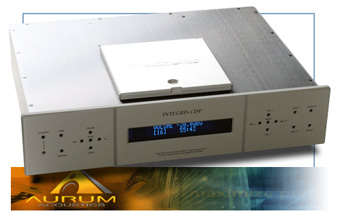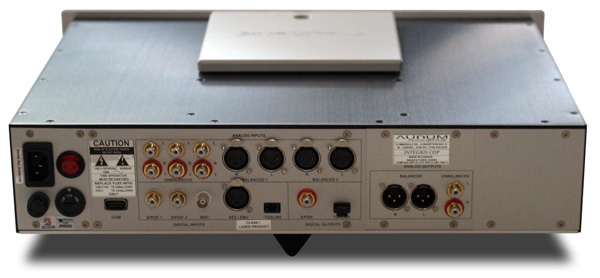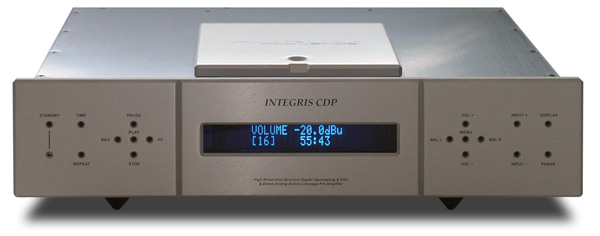![[SoundStage!]](../../titles/sslogo3.gif) Home
Audio Equipment Home
Audio EquipmentFeature Review |
|||||
Integration is happening everywhere in consumer electronics except high-end audio, which stubbornly persists in promoting the separate-box paradigm. Part of this is due, my cynical mind is sure, to simple economics: More boxes justify higher costs. However, another part has to do with performance. In order to provide the very best sonics, equipment designers have boiled each product down to its constituent parts, and then refined them to the nonessential. Two-box preamps are connected to mono amps, with a DAC and transport (each with separate power supplies) acting as digital source, a turntable/tonearm/cartridge triad and outboard phono stage providing vinyl playback. Subwoofers augment the bass of speakers that may have separate enclosures for bass, treble and midrange drivers. My system resembles the one that I've described, and the sheer complexity of it often causes non-audiophile visitors to stare and comment long before they hear any music. Even so, I like my audio system, and its intricacy doesn't seem untoward at all. Given this, it's no wonder that I completely forgot that the Aurum Acoustics Integris CDP CD player/preamp was coming my way until UPS delivered it. I had heard the Integris CDP at shows as part of a complete Aurum Acoustics audio system, and I enjoyed it in that context. This makes the Integris CDP doubly integrated -- combining two separate products into one chassis, and comprising part of a complete audio system -- which is a double whammy for the audiophile sensibility. While the idea of a combined preamp and CD player went against my personal grain and seemed a little wacky given the bulk of audio equipment in existence, I dutifully unboxed the Integris CDP and gave it shelf space on the Silent Running Craz 4 Reference rack that's the literal centerpiece of my system. The Integris CDP is the work of Derrick Moss, head of Aurum Acoustics and, I can attest from a few conversations, a fellow whose brain has some serious computing power. In an act of educational integration, Derrick followed up his degree in engineering with an MBA. The audiophile bug bit early on, and while there probably aren't too many engineers with MBAs, I can't think of two better degrees to have if you're going to build an audio company. Simplicity and directness are the guiding principles of the Integris CDP -- circuit simplicity and signal directness, that is. Inside you will see separate circuit boards for digital-to-analog conversion and resampling, the DAC/preamp output, the analog inputs, the digital inputs, and the power supply. In fact, as you look inside the Integris CDP, you may wonder why there isn't more in there, given that it performs the functions of two components. Again, simplicity and directness prevail. The volume control is a microprocessor-controlled analog circuit. A separate integrated circuit that acts as a variable resistor ladder in the loop of an external op-amp sets the gain. "The beauty of this," Derrick told me, "is that the volume control occurs in a very small physical space with only super-short uninterrupted PCB traces." While there are many ways to implement a volume control, Derrick believes in what he has done: "I would argue that this is better than a larger-scale implementation using discrete resistors, relays, wiper pots, maybe lots of wire, etc., etc."
Although the Integris CDP has XLR inputs and outputs, it is not fully balanced from input to output. Derrick is not a believer in "balanced circuits for the sake of balanced circuits." Sez he: "If you design a low-noise and low-distortion single-ended circuit (with balanced/bipolar power supplies) you have little or no need to employ a balanced signal design." Still, the Integris CDP is balanced to a degree. For CD playback and use with other digital sources:
For the balanced line-stage inputs:
The Integris CDP's shock-mounted Philips Pro 2M top-loading transport mechanism sends its output to an Anagram Quantum module, which uses Motorola SHARC processors to output 24-bit/192kHz digital data where 16-bit/44.1kHz data had existed. This goes to a pair of Analog Devices AD1893 DACs for conversion to analog. Internally there is room for greater mathematical horsepower in the form of a second Quantum module should Derrick decide to add it. There is also room for an extra analog-based module -- perhaps a headphone amp or phono stage. The Integris CDP's modular architecture makes updates and additions possible. The Integris CDP's preamp functionality is completely software controlled, so there are some snazzy features, including my favorite: input offset, which allows you to adjust the incoming analog signal +/-12dB to match the volume of sources to each other. You can also rename each of the five analog (three single ended, two balanced) and five digital inputs (two coax, one AES/EBU, one BNC, one TosLink), thereby customizing the Integris CDP. The unit's large blue display is bright enough to be readable from the listening position, even in a room like mine that's often awash in sunlight. The unit's remote control is actually a Logitech Harmony 676 that has been pre-configured for use with the Integris CDP. It is one of the best universal remotes on the market, but it does have a flaw: it positively eats batteries, going through a set of four AAs in about three months. Get your batteries at Costco, or consider upgrading to a Harmony 880, which is rechargeable. With either the 676 or 880, you can program the remote to operate other components via a USB connection to your computer. Even with all the user niceties and the programmable remote control, I do have a complaint about using the Integris CDP: I would have liked to be able to delete unused inputs from the listing, instead of having to cycle through them to get from CD playback with the Integris CDP to listening to another source. Derrick assures me that it's in the works: "Because the control system is entirely microprocessor driven, we can address it through a firmware update." The COM port needed for such updates is around back. Also around back are coaxial and TosLink digital outputs, sets of balanced and single-ended analog outputs, the master on/off switch, and the fuse holder. Regarding the latter, Derrick supplies an aftermarket Isoclean fuse that "just sounds better than the stock fuse." However, its 4A value is higher than the .25A fuse spec'ed for the Integris CDP, so make sure you don't have any issues before inserting the Isoclean fuse. The fuse is a sign of what I find most interesting about the Integris CDP: It's a well-engineered, well-made audio component whose designer doesn't chase theories for the sake of doing so, and concedes that it can be improved through tweaks whose effects he may not understand but he doesn't question when he hears them. For Derrick Moss, the proof is in the listening, and the Integris CDP bears this out. It is the best CD player with integral volume control that I've heard, beating out such notables as the Mark Levinson No.39 and No.390S, even Esoteric's P-70/D-70 combination. Furthermore, it is among the very best standalone CD players and preamps that I've heard. First and foremost, the Integris CDP is a truthful CD player. Its linear, transparent sound will tell you exactly what's on each of your CDs. However, along with this there is an endearing smoothness, a byproduct, I suspect, of the Anagram Quantum module -- you don't hear such smoothness from any old digital source. These two things were responsible for the most detailed and refined upper midrange and treble I've heard from digital, making piano in particular stand out. Not only did the Integris CDP dig deeply into faves from Bill Evans, Brad Meldau, Jessica Williams, and others, but its inherent high resolution never sounded clinical or made the music sound anything but involving, even lovely.
Just don't expect pizzazz from the Integris CDP. There is no added warmth or presence, no tonal niceties or anomalies of any kind. What you hear from CDs like Shawn Colvin's Cover Girl [Columbia CK 57875], whose ambience gives the music a thrilling sense of openness, is the portrayal of space but not via tubey bloom. Closed-in studio recordings like the Jacques Loussier Trio's Baroque Favorites [Telarc CD-83516] have a wonderful sense of presence that's inherent in the recording, not the Integris CDP. Because of this honesty, I can imagine some listeners finding the Integris CDP's sound boring. It's not contoured or pepped up; instead, the Integris CDP presents music through the proverbial clear window -- without extra drama, which it leaves to the music. I especially enjoyed the way the Integris CDP reproduced the many Blue Note RVG remasters I played. I own about 50 of these jazz classics, and each sounds lean and slightly treble-emphasized. You might think that a highly detailed source like the Integris CDP would turn these recordings into cold, hard marble, sonically speaking. Instead, the Integris CDP allowed me to hear into each recording, seemingly into the master tapes themselves, but without brittleness from the abundant high-frequency energy. The smoothness overcomes -- humanizes -- the recordings. Enhancing both the resolution and smoothness is the Integris CDP's extreme quietness. You can listen at low levels and not feel like the music is lost to the system's own noise floor. Of course, this supposes a system that's up to the task. Both the Lamm ML2.1 and M1.2 Reference amps were game, and so were the Wilson Audio Sophia 2 speakers. By comparison, the Verity Audio Parsifal Ovations, while always presenting music with great beauty, were a little less successful, as their warmth and slight darkness obscured some of the fine texture of instruments buried deep in the mix. Whether you like it or not, the Integris CDP lets you hear such things. The Integris CDP is light on its feet. Its sprightly, nimble character imparts a distinct sense of speed, perhaps due to a lack of additive weight. With some components, this can be a sign of a basic forwardness that gives the illusion of speed and dexterity. Not so with the Integris CDP, whose dominant neutrality, resolution and transparency do not result in a concomitant forwardness. The Integris CDP gives a clear audible "view" from the middle of the hall, not a neck-straining front-row seat.
Used as a preamp, the Integris CDP sounds like it does when playing CDs, which implies that Derrick Moss has balanced the sonics of the unit well, not trying to offset a characteristic of the CD playback with something in the preamp's performance. This, along with the ability to adjust the level of each input, made the Integris CDP very useful for comparing CD, SACD and universal players. The sound of the Esoteric X-01 Limited, for instance, has more presence in the midrange and weight in the bass, but it can't match the Integris CDP's quickness into and out of each note or its overall high resolution. The tubed Audio Research Reference CD7 sounds far more robust and full, likely because of its tubes. Its big, bold sound is easy to appreciate, while the Integris CDP is modest in asserting its sonic personality, each recording sounding more individual and less like others. There were a few times, however, that I could tell the Integris CDP wasn't capturing the gestalt of the bass on certain recordings to the degree that the ARC and Esoteric players were. I'd switch back and forth -- again, the Integris CDP's preamp functionality made this soooo easy -- and note a little more growl or projection from bass guitar or upright bass via the ARC and Esoteric units. I listened to these players and others, including the Ayre C-5xe and Esoteric P-03/D-03 combo, via the Audio Research Reference 3 preamp, inserting the Integris CDP once I was sure I had forgotten what I enjoyed so much about it. It all came back in seconds, and I'd be tapping my foot again. Even so, I wouldn't recommend such an unadorned, high-resolution source for just any system. Aurum's dedicated amp for its speaker system uses 300B output tubes, and you can hear their effect in the ravishing sound they help produce. However, I think that using the Integris CDP with, say, a pair of Halcro amps would turn the amps' leanness into skin-and-bone emaciation. I absolutely loved the Integris CDP with my Lamm ML2.1 SET monoblocks, and it was no slouch with the M1.2 Reference hybrid amps either -- or an Audio Research Reference 110 that arrived a couple of weeks ago. Still, the Integris CDP was built for use as the front-end of Derrick Moss's all-in-one system, and that is where I bow out and Doug Schneider takes over. Look for Doug's half of this integrated review on October 1. ...Marc Mickelson
|
|||||
|
|||||
![[SoundStage!]](../../titles/sslogo3.gif) All
Contents All
ContentsCopyright © 2006 SoundStage! All Rights Reserved |



